Professional Reflection in Nursing: Gibbs Reflection Journal
VerifiedAdded on 2022/06/14
|8
|2180
|122
Journal and Reflective Writing
AI Summary
This Gibbs Reflection Journal, submitted by a nursing student, utilizes the Gibbs reflective cycle to analyze three distinct scenarios encountered during their studies and clinical practice. The first scenario focuses on a challenging experience educating Aboriginal people about diabetes, highlighting the importance of cultural sensitivity and effective communication strategies. The second scenario details a case involving a low birth weight baby and the mother's lack of prenatal supplement intake, emphasizing the significance of maternal health education and preventative measures. The third scenario discusses a demanding shift in a medical ward with significant staffing shortages, addressing medication administration and patient care challenges. Each scenario includes descriptions of the situations, the student's feelings, evaluations of the experiences, detailed analyses, conclusions about what was learned, and actionable plans for future situations. The journal also includes references to relevant literature supporting the student's reflections and insights.
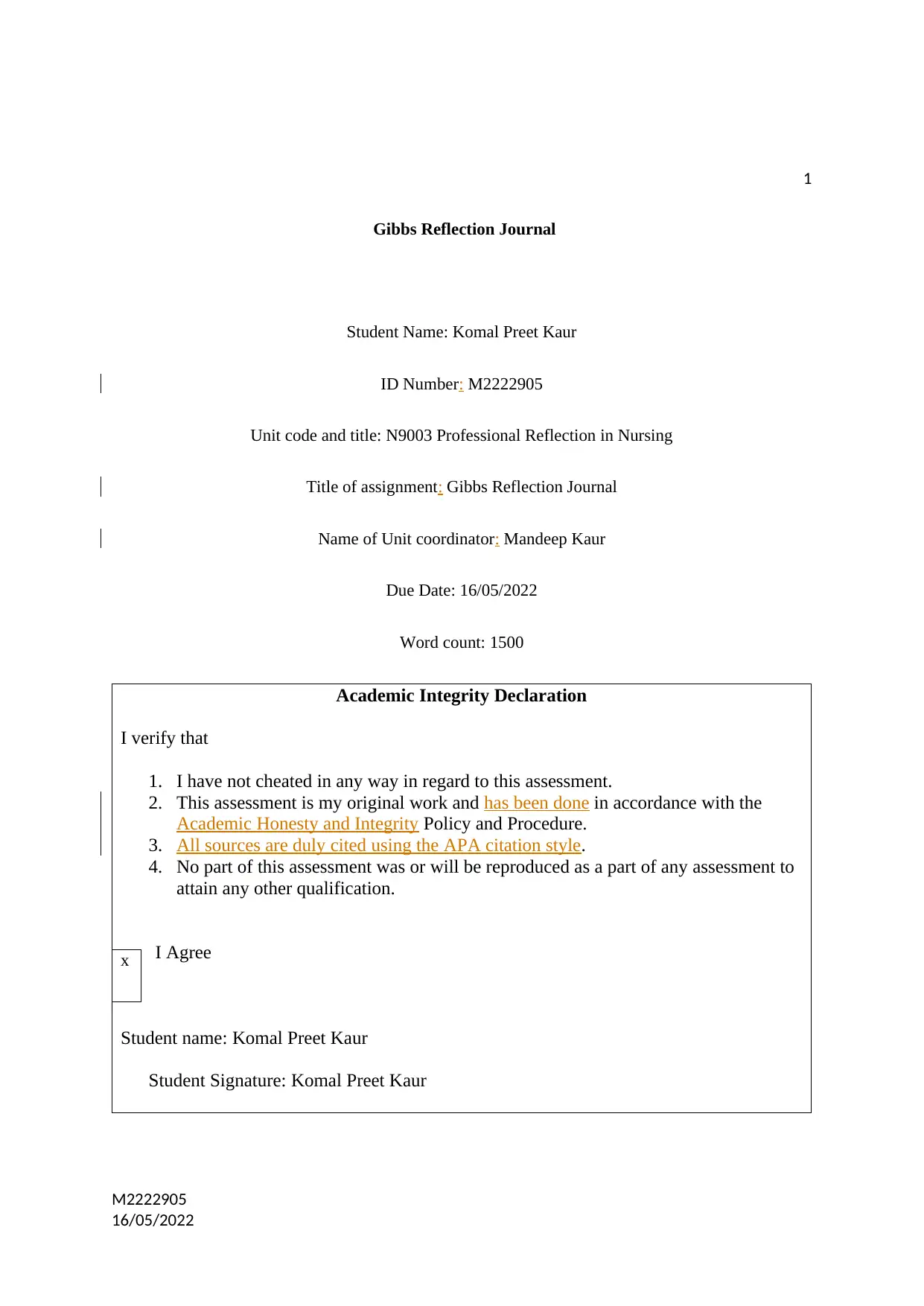
1
Gibbs Reflection Journal
Student Name: Komal Preet Kaur
ID Number: M2222905
Unit code and title: N9003 Professional Reflection in Nursing
Title of assignment: Gibbs Reflection Journal
Name of Unit coordinator: Mandeep Kaur
Due Date: 16/05/2022
Word count: 1500
Academic Integrity Declaration
I verify that
1. I have not cheated in any way in regard to this assessment.
2. This assessment is my original work and has been done in accordance with the
Academic Honesty and Integrity Policy and Procedure.
3. All sources are duly cited using the APA citation style.
4. No part of this assessment was or will be reproduced as a part of any assessment to
attain any other qualification.
I Agree
Student name: Komal Preet Kaur
Student Signature: Komal Preet Kaur
M2222905
16/05/2022
x
Gibbs Reflection Journal
Student Name: Komal Preet Kaur
ID Number: M2222905
Unit code and title: N9003 Professional Reflection in Nursing
Title of assignment: Gibbs Reflection Journal
Name of Unit coordinator: Mandeep Kaur
Due Date: 16/05/2022
Word count: 1500
Academic Integrity Declaration
I verify that
1. I have not cheated in any way in regard to this assessment.
2. This assessment is my original work and has been done in accordance with the
Academic Honesty and Integrity Policy and Procedure.
3. All sources are duly cited using the APA citation style.
4. No part of this assessment was or will be reproduced as a part of any assessment to
attain any other qualification.
I Agree
Student name: Komal Preet Kaur
Student Signature: Komal Preet Kaur
M2222905
16/05/2022
x
Paraphrase This Document
Need a fresh take? Get an instant paraphrase of this document with our AI Paraphraser
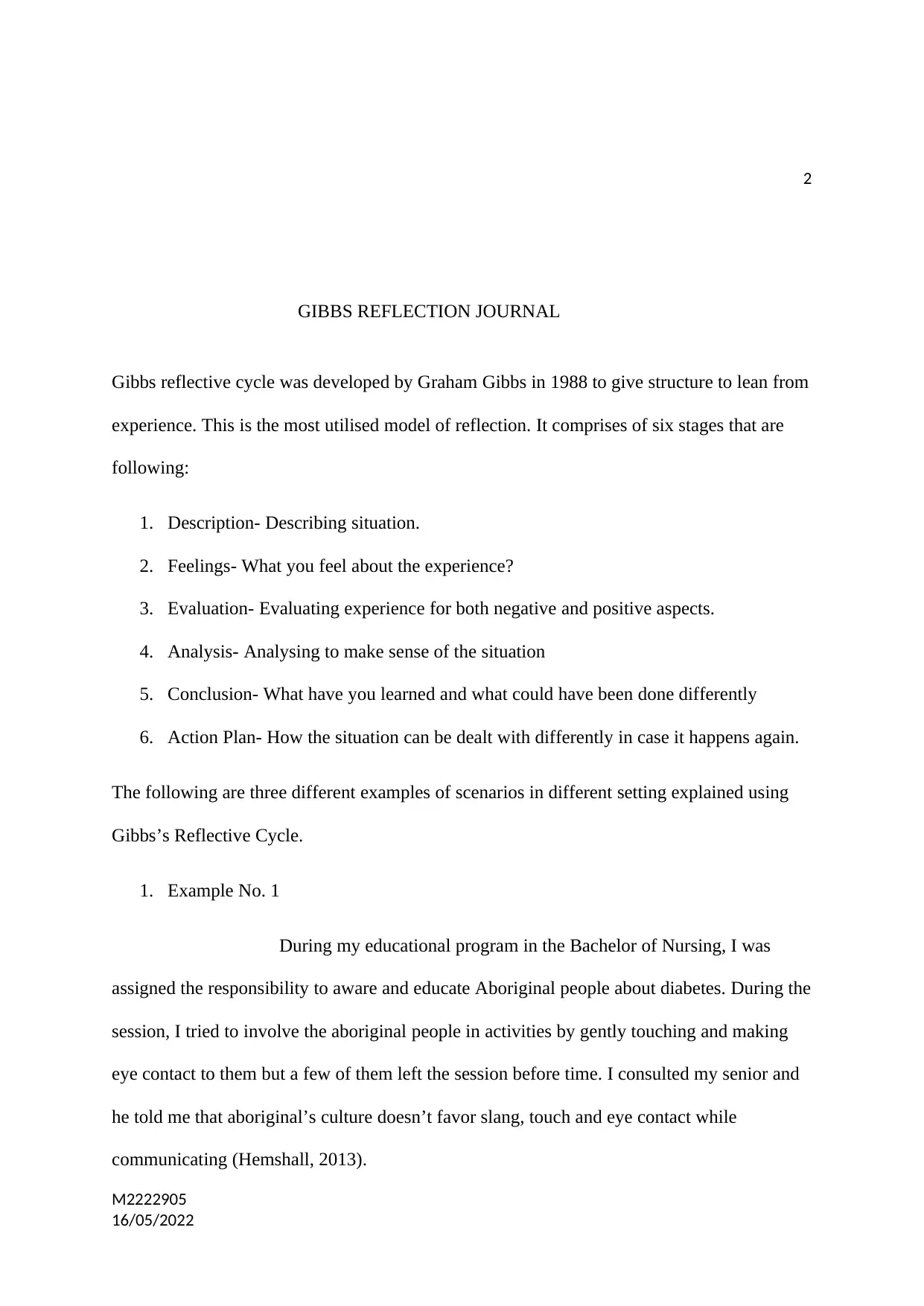
2
GIBBS REFLECTION JOURNAL
Gibbs reflective cycle was developed by Graham Gibbs in 1988 to give structure to lean from
experience. This is the most utilised model of reflection. It comprises of six stages that are
following:
1. Description- Describing situation.
2. Feelings- What you feel about the experience?
3. Evaluation- Evaluating experience for both negative and positive aspects.
4. Analysis- Analysing to make sense of the situation
5. Conclusion- What have you learned and what could have been done differently
6. Action Plan- How the situation can be dealt with differently in case it happens again.
The following are three different examples of scenarios in different setting explained using
Gibbs’s Reflective Cycle.
1. Example No. 1
During my educational program in the Bachelor of Nursing, I was
assigned the responsibility to aware and educate Aboriginal people about diabetes. During the
session, I tried to involve the aboriginal people in activities by gently touching and making
eye contact to them but a few of them left the session before time. I consulted my senior and
he told me that aboriginal’s culture doesn’t favor slang, touch and eye contact while
communicating (Hemshall, 2013).
M2222905
16/05/2022
GIBBS REFLECTION JOURNAL
Gibbs reflective cycle was developed by Graham Gibbs in 1988 to give structure to lean from
experience. This is the most utilised model of reflection. It comprises of six stages that are
following:
1. Description- Describing situation.
2. Feelings- What you feel about the experience?
3. Evaluation- Evaluating experience for both negative and positive aspects.
4. Analysis- Analysing to make sense of the situation
5. Conclusion- What have you learned and what could have been done differently
6. Action Plan- How the situation can be dealt with differently in case it happens again.
The following are three different examples of scenarios in different setting explained using
Gibbs’s Reflective Cycle.
1. Example No. 1
During my educational program in the Bachelor of Nursing, I was
assigned the responsibility to aware and educate Aboriginal people about diabetes. During the
session, I tried to involve the aboriginal people in activities by gently touching and making
eye contact to them but a few of them left the session before time. I consulted my senior and
he told me that aboriginal’s culture doesn’t favor slang, touch and eye contact while
communicating (Hemshall, 2013).
M2222905
16/05/2022
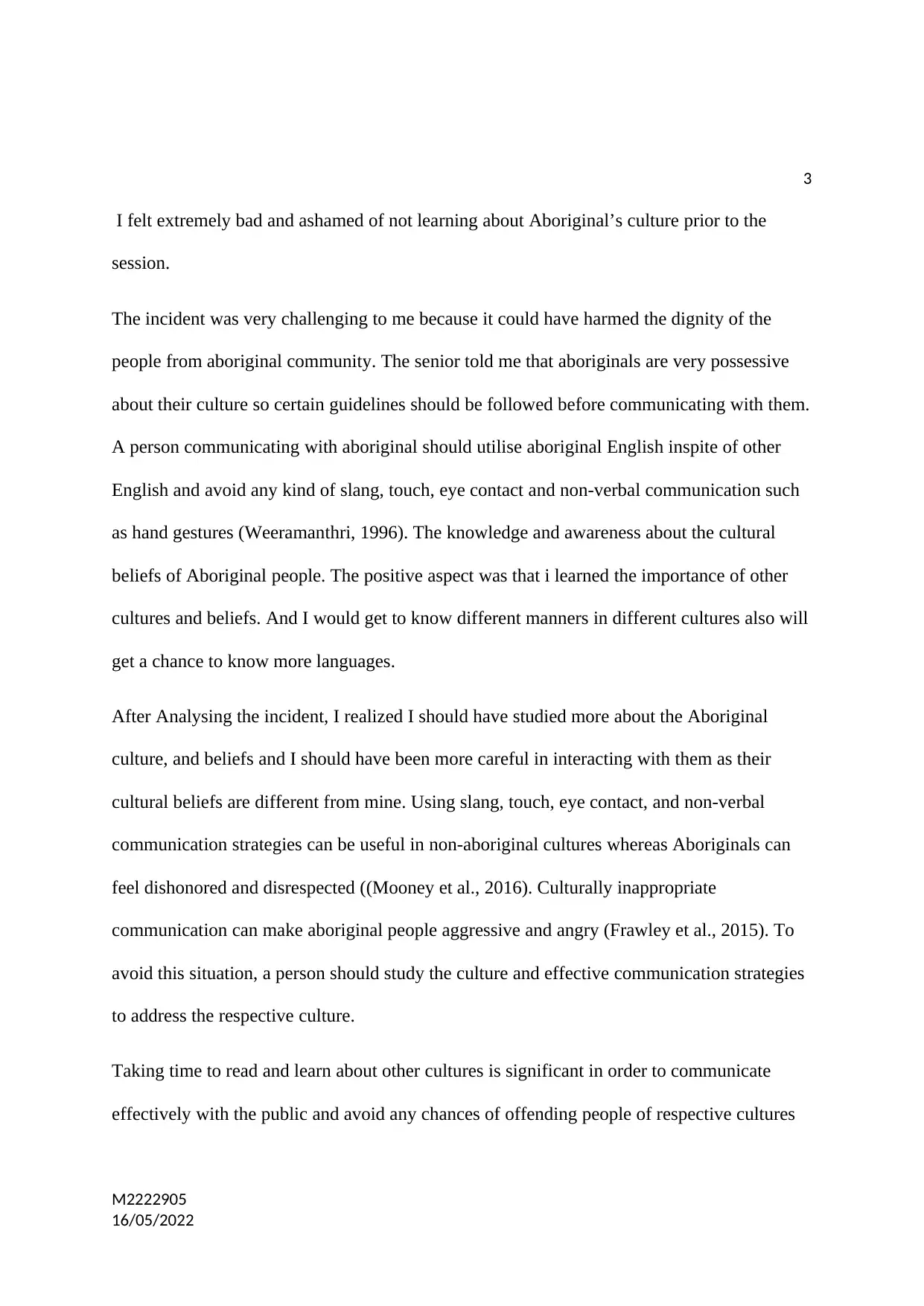
3
I felt extremely bad and ashamed of not learning about Aboriginal’s culture prior to the
session.
The incident was very challenging to me because it could have harmed the dignity of the
people from aboriginal community. The senior told me that aboriginals are very possessive
about their culture so certain guidelines should be followed before communicating with them.
A person communicating with aboriginal should utilise aboriginal English inspite of other
English and avoid any kind of slang, touch, eye contact and non-verbal communication such
as hand gestures (Weeramanthri, 1996). The knowledge and awareness about the cultural
beliefs of Aboriginal people. The positive aspect was that i learned the importance of other
cultures and beliefs. And I would get to know different manners in different cultures also will
get a chance to know more languages.
After Analysing the incident, I realized I should have studied more about the Aboriginal
culture, and beliefs and I should have been more careful in interacting with them as their
cultural beliefs are different from mine. Using slang, touch, eye contact, and non-verbal
communication strategies can be useful in non-aboriginal cultures whereas Aboriginals can
feel dishonored and disrespected ((Mooney et al., 2016). Culturally inappropriate
communication can make aboriginal people aggressive and angry (Frawley et al., 2015). To
avoid this situation, a person should study the culture and effective communication strategies
to address the respective culture.
Taking time to read and learn about other cultures is significant in order to communicate
effectively with the public and avoid any chances of offending people of respective cultures
M2222905
16/05/2022
I felt extremely bad and ashamed of not learning about Aboriginal’s culture prior to the
session.
The incident was very challenging to me because it could have harmed the dignity of the
people from aboriginal community. The senior told me that aboriginals are very possessive
about their culture so certain guidelines should be followed before communicating with them.
A person communicating with aboriginal should utilise aboriginal English inspite of other
English and avoid any kind of slang, touch, eye contact and non-verbal communication such
as hand gestures (Weeramanthri, 1996). The knowledge and awareness about the cultural
beliefs of Aboriginal people. The positive aspect was that i learned the importance of other
cultures and beliefs. And I would get to know different manners in different cultures also will
get a chance to know more languages.
After Analysing the incident, I realized I should have studied more about the Aboriginal
culture, and beliefs and I should have been more careful in interacting with them as their
cultural beliefs are different from mine. Using slang, touch, eye contact, and non-verbal
communication strategies can be useful in non-aboriginal cultures whereas Aboriginals can
feel dishonored and disrespected ((Mooney et al., 2016). Culturally inappropriate
communication can make aboriginal people aggressive and angry (Frawley et al., 2015). To
avoid this situation, a person should study the culture and effective communication strategies
to address the respective culture.
Taking time to read and learn about other cultures is significant in order to communicate
effectively with the public and avoid any chances of offending people of respective cultures
M2222905
16/05/2022
You're viewing a preview
Unlock full access by subscribing today!
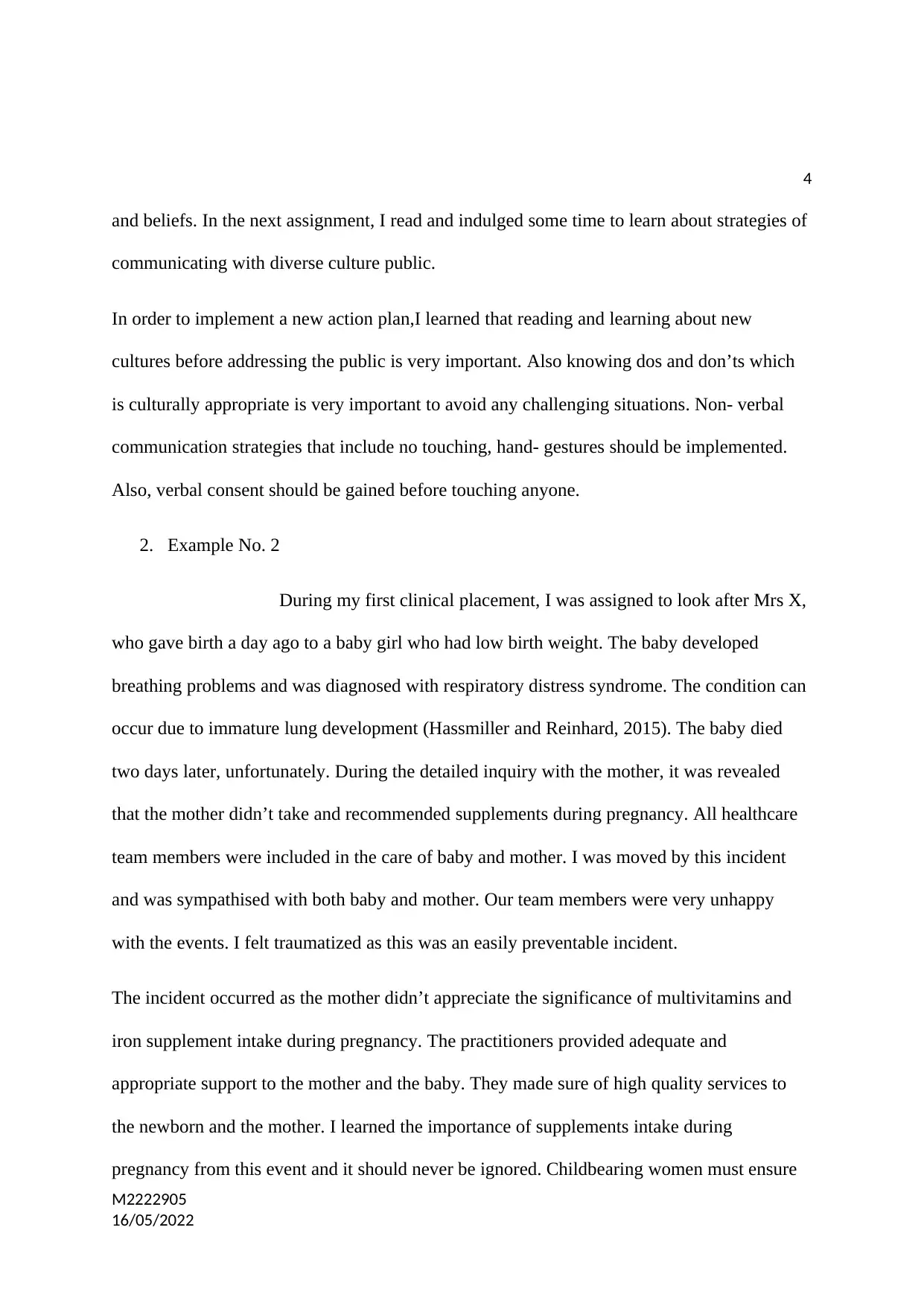
4
and beliefs. In the next assignment, I read and indulged some time to learn about strategies of
communicating with diverse culture public.
In order to implement a new action plan,I learned that reading and learning about new
cultures before addressing the public is very important. Also knowing dos and don’ts which
is culturally appropriate is very important to avoid any challenging situations. Non- verbal
communication strategies that include no touching, hand- gestures should be implemented.
Also, verbal consent should be gained before touching anyone.
2. Example No. 2
During my first clinical placement, I was assigned to look after Mrs X,
who gave birth a day ago to a baby girl who had low birth weight. The baby developed
breathing problems and was diagnosed with respiratory distress syndrome. The condition can
occur due to immature lung development (Hassmiller and Reinhard, 2015). The baby died
two days later, unfortunately. During the detailed inquiry with the mother, it was revealed
that the mother didn’t take and recommended supplements during pregnancy. All healthcare
team members were included in the care of baby and mother. I was moved by this incident
and was sympathised with both baby and mother. Our team members were very unhappy
with the events. I felt traumatized as this was an easily preventable incident.
The incident occurred as the mother didn’t appreciate the significance of multivitamins and
iron supplement intake during pregnancy. The practitioners provided adequate and
appropriate support to the mother and the baby. They made sure of high quality services to
the newborn and the mother. I learned the importance of supplements intake during
pregnancy from this event and it should never be ignored. Childbearing women must ensure
M2222905
16/05/2022
and beliefs. In the next assignment, I read and indulged some time to learn about strategies of
communicating with diverse culture public.
In order to implement a new action plan,I learned that reading and learning about new
cultures before addressing the public is very important. Also knowing dos and don’ts which
is culturally appropriate is very important to avoid any challenging situations. Non- verbal
communication strategies that include no touching, hand- gestures should be implemented.
Also, verbal consent should be gained before touching anyone.
2. Example No. 2
During my first clinical placement, I was assigned to look after Mrs X,
who gave birth a day ago to a baby girl who had low birth weight. The baby developed
breathing problems and was diagnosed with respiratory distress syndrome. The condition can
occur due to immature lung development (Hassmiller and Reinhard, 2015). The baby died
two days later, unfortunately. During the detailed inquiry with the mother, it was revealed
that the mother didn’t take and recommended supplements during pregnancy. All healthcare
team members were included in the care of baby and mother. I was moved by this incident
and was sympathised with both baby and mother. Our team members were very unhappy
with the events. I felt traumatized as this was an easily preventable incident.
The incident occurred as the mother didn’t appreciate the significance of multivitamins and
iron supplement intake during pregnancy. The practitioners provided adequate and
appropriate support to the mother and the baby. They made sure of high quality services to
the newborn and the mother. I learned the importance of supplements intake during
pregnancy from this event and it should never be ignored. Childbearing women must ensure
M2222905
16/05/2022
Paraphrase This Document
Need a fresh take? Get an instant paraphrase of this document with our AI Paraphraser
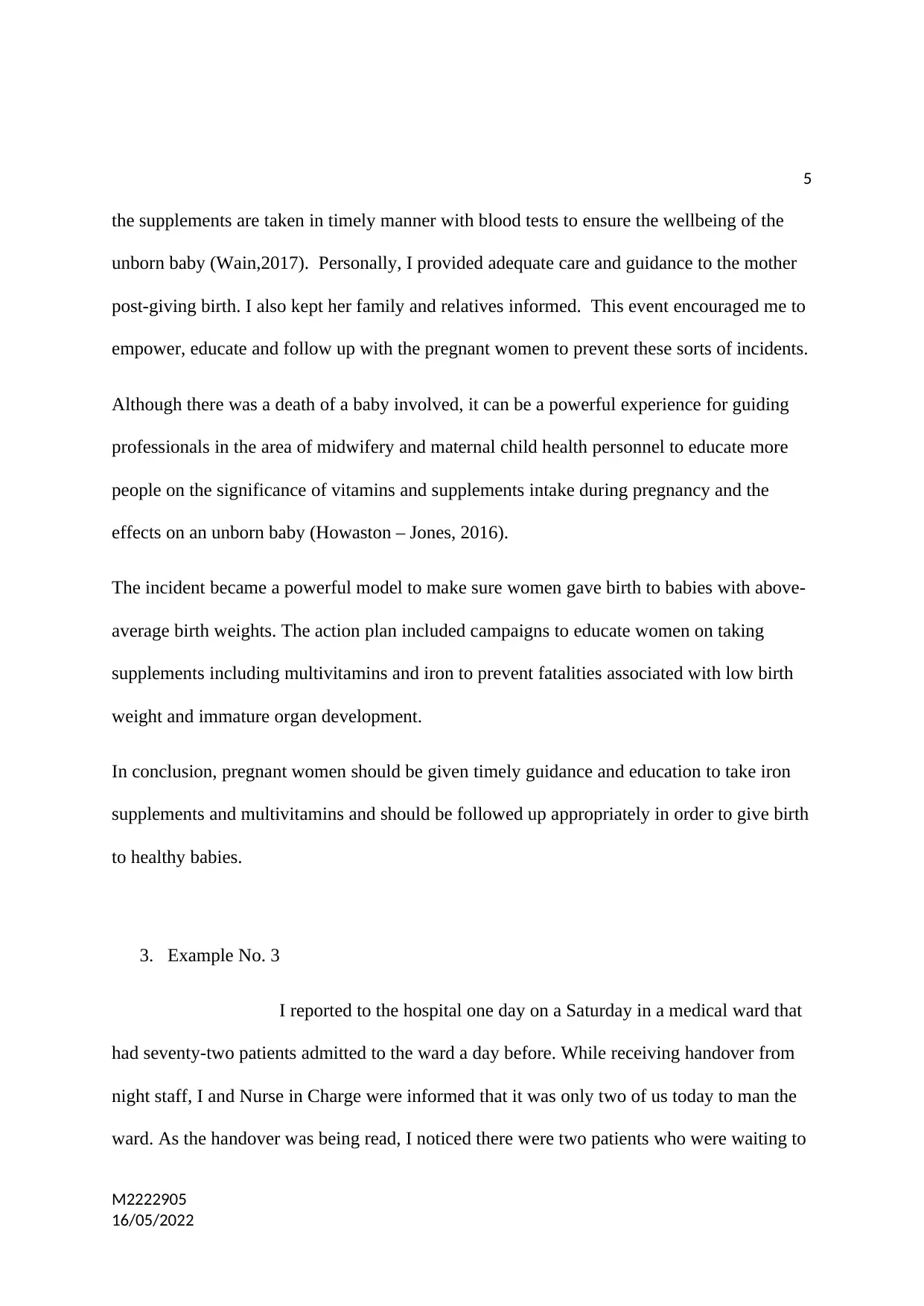
5
the supplements are taken in timely manner with blood tests to ensure the wellbeing of the
unborn baby (Wain,2017). Personally, I provided adequate care and guidance to the mother
post-giving birth. I also kept her family and relatives informed. This event encouraged me to
empower, educate and follow up with the pregnant women to prevent these sorts of incidents.
Although there was a death of a baby involved, it can be a powerful experience for guiding
professionals in the area of midwifery and maternal child health personnel to educate more
people on the significance of vitamins and supplements intake during pregnancy and the
effects on an unborn baby (Howaston – Jones, 2016).
The incident became a powerful model to make sure women gave birth to babies with above-
average birth weights. The action plan included campaigns to educate women on taking
supplements including multivitamins and iron to prevent fatalities associated with low birth
weight and immature organ development.
In conclusion, pregnant women should be given timely guidance and education to take iron
supplements and multivitamins and should be followed up appropriately in order to give birth
to healthy babies.
3. Example No. 3
I reported to the hospital one day on a Saturday in a medical ward that
had seventy-two patients admitted to the ward a day before. While receiving handover from
night staff, I and Nurse in Charge were informed that it was only two of us today to man the
ward. As the handover was being read, I noticed there were two patients who were waiting to
M2222905
16/05/2022
the supplements are taken in timely manner with blood tests to ensure the wellbeing of the
unborn baby (Wain,2017). Personally, I provided adequate care and guidance to the mother
post-giving birth. I also kept her family and relatives informed. This event encouraged me to
empower, educate and follow up with the pregnant women to prevent these sorts of incidents.
Although there was a death of a baby involved, it can be a powerful experience for guiding
professionals in the area of midwifery and maternal child health personnel to educate more
people on the significance of vitamins and supplements intake during pregnancy and the
effects on an unborn baby (Howaston – Jones, 2016).
The incident became a powerful model to make sure women gave birth to babies with above-
average birth weights. The action plan included campaigns to educate women on taking
supplements including multivitamins and iron to prevent fatalities associated with low birth
weight and immature organ development.
In conclusion, pregnant women should be given timely guidance and education to take iron
supplements and multivitamins and should be followed up appropriately in order to give birth
to healthy babies.
3. Example No. 3
I reported to the hospital one day on a Saturday in a medical ward that
had seventy-two patients admitted to the ward a day before. While receiving handover from
night staff, I and Nurse in Charge were informed that it was only two of us today to man the
ward. As the handover was being read, I noticed there were two patients who were waiting to
M2222905
16/05/2022
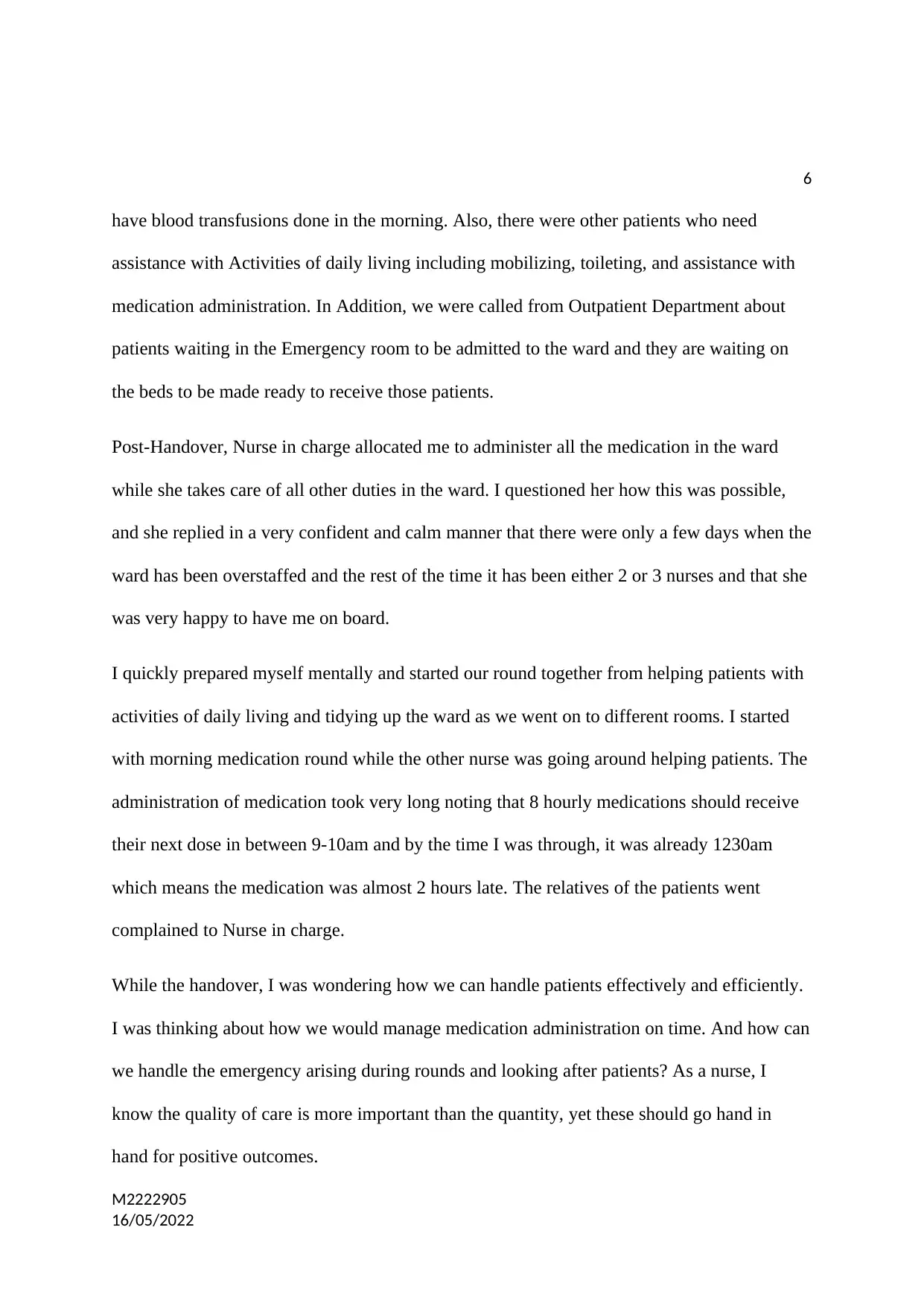
6
have blood transfusions done in the morning. Also, there were other patients who need
assistance with Activities of daily living including mobilizing, toileting, and assistance with
medication administration. In Addition, we were called from Outpatient Department about
patients waiting in the Emergency room to be admitted to the ward and they are waiting on
the beds to be made ready to receive those patients.
Post-Handover, Nurse in charge allocated me to administer all the medication in the ward
while she takes care of all other duties in the ward. I questioned her how this was possible,
and she replied in a very confident and calm manner that there were only a few days when the
ward has been overstaffed and the rest of the time it has been either 2 or 3 nurses and that she
was very happy to have me on board.
I quickly prepared myself mentally and started our round together from helping patients with
activities of daily living and tidying up the ward as we went on to different rooms. I started
with morning medication round while the other nurse was going around helping patients. The
administration of medication took very long noting that 8 hourly medications should receive
their next dose in between 9-10am and by the time I was through, it was already 1230am
which means the medication was almost 2 hours late. The relatives of the patients went
complained to Nurse in charge.
While the handover, I was wondering how we can handle patients effectively and efficiently.
I was thinking about how we would manage medication administration on time. And how can
we handle the emergency arising during rounds and looking after patients? As a nurse, I
know the quality of care is more important than the quantity, yet these should go hand in
hand for positive outcomes.
M2222905
16/05/2022
have blood transfusions done in the morning. Also, there were other patients who need
assistance with Activities of daily living including mobilizing, toileting, and assistance with
medication administration. In Addition, we were called from Outpatient Department about
patients waiting in the Emergency room to be admitted to the ward and they are waiting on
the beds to be made ready to receive those patients.
Post-Handover, Nurse in charge allocated me to administer all the medication in the ward
while she takes care of all other duties in the ward. I questioned her how this was possible,
and she replied in a very confident and calm manner that there were only a few days when the
ward has been overstaffed and the rest of the time it has been either 2 or 3 nurses and that she
was very happy to have me on board.
I quickly prepared myself mentally and started our round together from helping patients with
activities of daily living and tidying up the ward as we went on to different rooms. I started
with morning medication round while the other nurse was going around helping patients. The
administration of medication took very long noting that 8 hourly medications should receive
their next dose in between 9-10am and by the time I was through, it was already 1230am
which means the medication was almost 2 hours late. The relatives of the patients went
complained to Nurse in charge.
While the handover, I was wondering how we can handle patients effectively and efficiently.
I was thinking about how we would manage medication administration on time. And how can
we handle the emergency arising during rounds and looking after patients? As a nurse, I
know the quality of care is more important than the quantity, yet these should go hand in
hand for positive outcomes.
M2222905
16/05/2022
You're viewing a preview
Unlock full access by subscribing today!
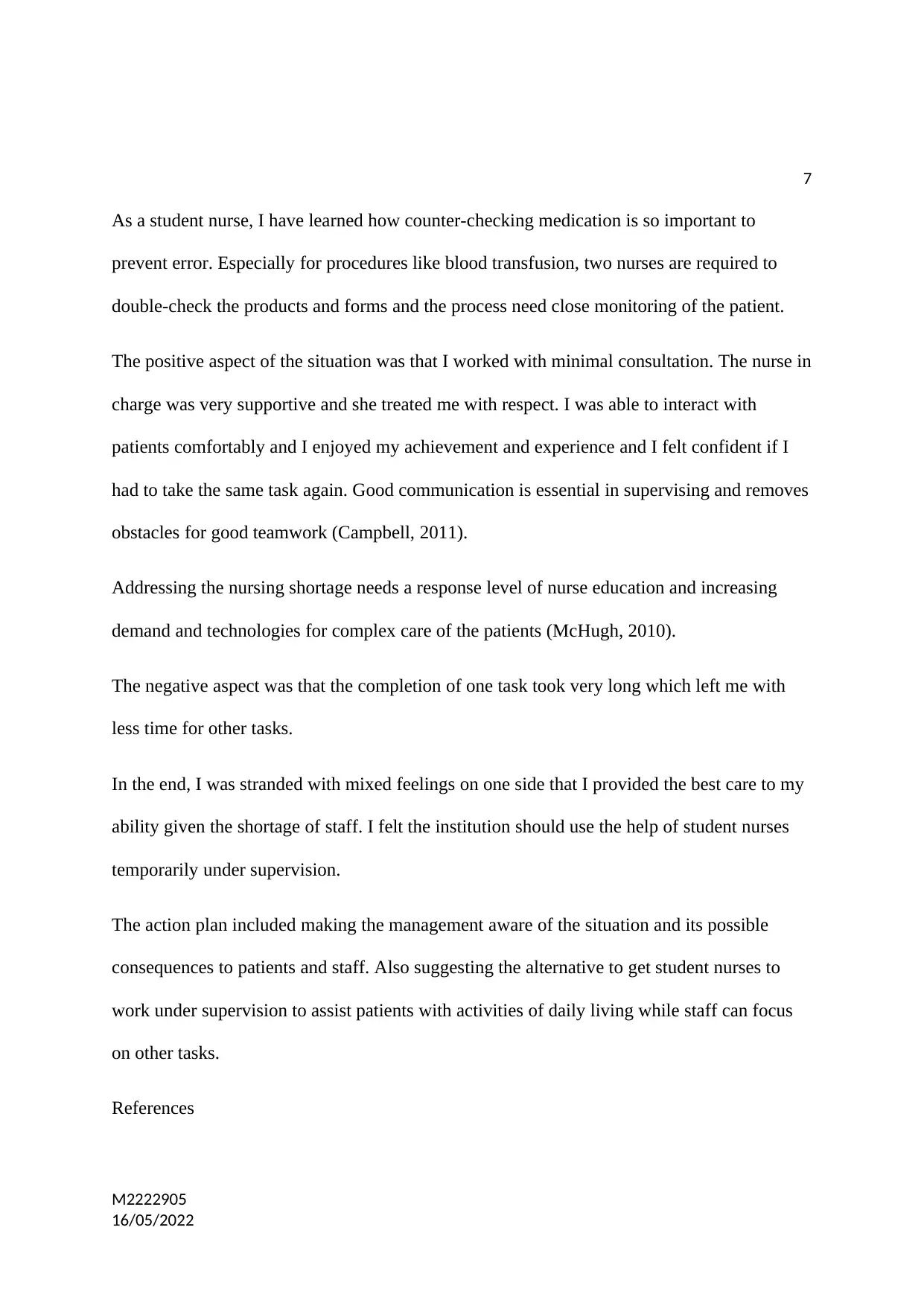
7
As a student nurse, I have learned how counter-checking medication is so important to
prevent error. Especially for procedures like blood transfusion, two nurses are required to
double-check the products and forms and the process need close monitoring of the patient.
The positive aspect of the situation was that I worked with minimal consultation. The nurse in
charge was very supportive and she treated me with respect. I was able to interact with
patients comfortably and I enjoyed my achievement and experience and I felt confident if I
had to take the same task again. Good communication is essential in supervising and removes
obstacles for good teamwork (Campbell, 2011).
Addressing the nursing shortage needs a response level of nurse education and increasing
demand and technologies for complex care of the patients (McHugh, 2010).
The negative aspect was that the completion of one task took very long which left me with
less time for other tasks.
In the end, I was stranded with mixed feelings on one side that I provided the best care to my
ability given the shortage of staff. I felt the institution should use the help of student nurses
temporarily under supervision.
The action plan included making the management aware of the situation and its possible
consequences to patients and staff. Also suggesting the alternative to get student nurses to
work under supervision to assist patients with activities of daily living while staff can focus
on other tasks.
References
M2222905
16/05/2022
As a student nurse, I have learned how counter-checking medication is so important to
prevent error. Especially for procedures like blood transfusion, two nurses are required to
double-check the products and forms and the process need close monitoring of the patient.
The positive aspect of the situation was that I worked with minimal consultation. The nurse in
charge was very supportive and she treated me with respect. I was able to interact with
patients comfortably and I enjoyed my achievement and experience and I felt confident if I
had to take the same task again. Good communication is essential in supervising and removes
obstacles for good teamwork (Campbell, 2011).
Addressing the nursing shortage needs a response level of nurse education and increasing
demand and technologies for complex care of the patients (McHugh, 2010).
The negative aspect was that the completion of one task took very long which left me with
less time for other tasks.
In the end, I was stranded with mixed feelings on one side that I provided the best care to my
ability given the shortage of staff. I felt the institution should use the help of student nurses
temporarily under supervision.
The action plan included making the management aware of the situation and its possible
consequences to patients and staff. Also suggesting the alternative to get student nurses to
work under supervision to assist patients with activities of daily living while staff can focus
on other tasks.
References
M2222905
16/05/2022
Paraphrase This Document
Need a fresh take? Get an instant paraphrase of this document with our AI Paraphraser
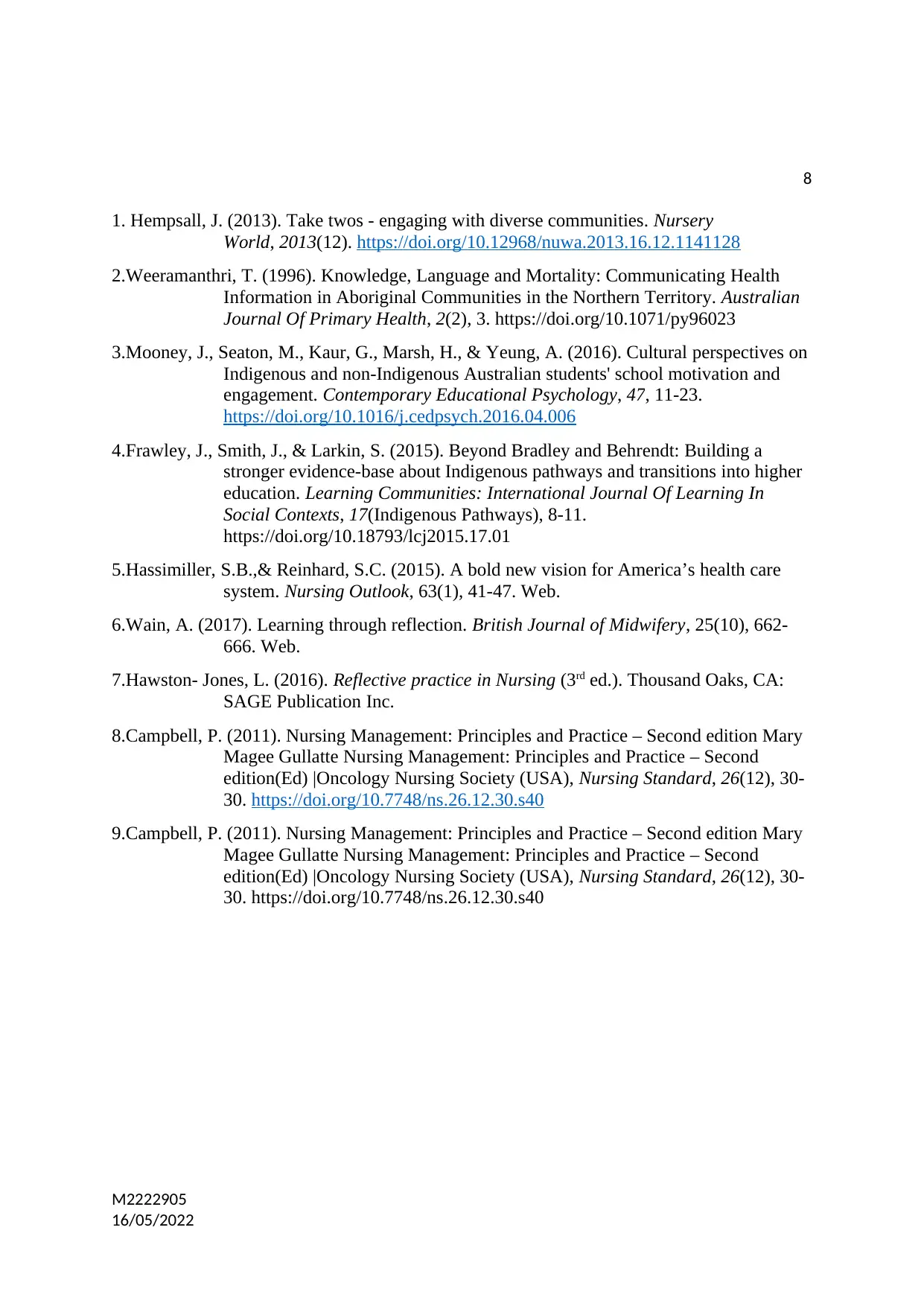
8
1. Hempsall, J. (2013). Take twos - engaging with diverse communities. Nursery
World, 2013(12). https://doi.org/10.12968/nuwa.2013.16.12.1141128
2.Weeramanthri, T. (1996). Knowledge, Language and Mortality: Communicating Health
Information in Aboriginal Communities in the Northern Territory. Australian
Journal Of Primary Health, 2(2), 3. https://doi.org/10.1071/py96023
3.Mooney, J., Seaton, M., Kaur, G., Marsh, H., & Yeung, A. (2016). Cultural perspectives on
Indigenous and non-Indigenous Australian students' school motivation and
engagement. Contemporary Educational Psychology, 47, 11-23.
https://doi.org/10.1016/j.cedpsych.2016.04.006
4.Frawley, J., Smith, J., & Larkin, S. (2015). Beyond Bradley and Behrendt: Building a
stronger evidence-base about Indigenous pathways and transitions into higher
education. Learning Communities: International Journal Of Learning In
Social Contexts, 17(Indigenous Pathways), 8-11.
https://doi.org/10.18793/lcj2015.17.01
5.Hassimiller, S.B.,& Reinhard, S.C. (2015). A bold new vision for America’s health care
system. Nursing Outlook, 63(1), 41-47. Web.
6.Wain, A. (2017). Learning through reflection. British Journal of Midwifery, 25(10), 662-
666. Web.
7.Hawston- Jones, L. (2016). Reflective practice in Nursing (3rd ed.). Thousand Oaks, CA:
SAGE Publication Inc.
8.Campbell, P. (2011). Nursing Management: Principles and Practice – Second edition Mary
Magee Gullatte Nursing Management: Principles and Practice – Second
edition(Ed) |Oncology Nursing Society (USA), Nursing Standard, 26(12), 30-
30. https://doi.org/10.7748/ns.26.12.30.s40
9.Campbell, P. (2011). Nursing Management: Principles and Practice – Second edition Mary
Magee Gullatte Nursing Management: Principles and Practice – Second
edition(Ed) |Oncology Nursing Society (USA), Nursing Standard, 26(12), 30-
30. https://doi.org/10.7748/ns.26.12.30.s40
M2222905
16/05/2022
1. Hempsall, J. (2013). Take twos - engaging with diverse communities. Nursery
World, 2013(12). https://doi.org/10.12968/nuwa.2013.16.12.1141128
2.Weeramanthri, T. (1996). Knowledge, Language and Mortality: Communicating Health
Information in Aboriginal Communities in the Northern Territory. Australian
Journal Of Primary Health, 2(2), 3. https://doi.org/10.1071/py96023
3.Mooney, J., Seaton, M., Kaur, G., Marsh, H., & Yeung, A. (2016). Cultural perspectives on
Indigenous and non-Indigenous Australian students' school motivation and
engagement. Contemporary Educational Psychology, 47, 11-23.
https://doi.org/10.1016/j.cedpsych.2016.04.006
4.Frawley, J., Smith, J., & Larkin, S. (2015). Beyond Bradley and Behrendt: Building a
stronger evidence-base about Indigenous pathways and transitions into higher
education. Learning Communities: International Journal Of Learning In
Social Contexts, 17(Indigenous Pathways), 8-11.
https://doi.org/10.18793/lcj2015.17.01
5.Hassimiller, S.B.,& Reinhard, S.C. (2015). A bold new vision for America’s health care
system. Nursing Outlook, 63(1), 41-47. Web.
6.Wain, A. (2017). Learning through reflection. British Journal of Midwifery, 25(10), 662-
666. Web.
7.Hawston- Jones, L. (2016). Reflective practice in Nursing (3rd ed.). Thousand Oaks, CA:
SAGE Publication Inc.
8.Campbell, P. (2011). Nursing Management: Principles and Practice – Second edition Mary
Magee Gullatte Nursing Management: Principles and Practice – Second
edition(Ed) |Oncology Nursing Society (USA), Nursing Standard, 26(12), 30-
30. https://doi.org/10.7748/ns.26.12.30.s40
9.Campbell, P. (2011). Nursing Management: Principles and Practice – Second edition Mary
Magee Gullatte Nursing Management: Principles and Practice – Second
edition(Ed) |Oncology Nursing Society (USA), Nursing Standard, 26(12), 30-
30. https://doi.org/10.7748/ns.26.12.30.s40
M2222905
16/05/2022
1 out of 8
Related Documents
Your All-in-One AI-Powered Toolkit for Academic Success.
+13062052269
info@desklib.com
Available 24*7 on WhatsApp / Email
![[object Object]](/_next/static/media/star-bottom.7253800d.svg)
Unlock your academic potential
© 2024 | Zucol Services PVT LTD | All rights reserved.




